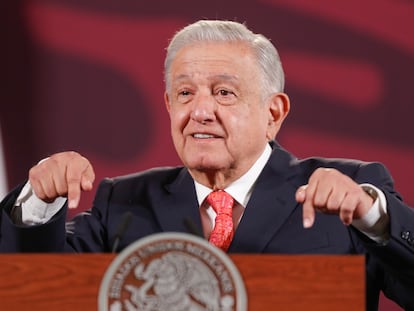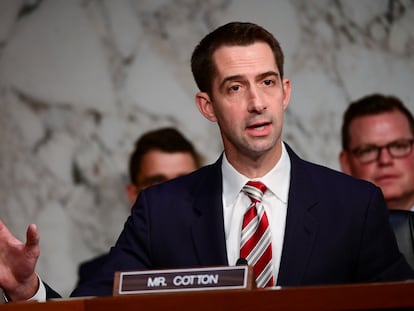The DEA’s crusade against the Sinaloa and Jalisco cartels: ‘The most dangerous and deadly drug crisis the US has ever faced’
The latest annual report from the anti-narcotics agency warns that the two criminal groups ‘have effectively eliminated any competition’ and already have a presence in all 50 states of the country

The Sinaloa Cartel and the Jalisco New Generation Cartel (CJNG) are the main subjects of the latest U.S. Drug Enforcement Agency (DEA) annual report, published amid fresh tension with the government of Andrés Manuel López Obrador over claims made this week before the House of Representatives concerning delays in the delivery of visas for its agents deployed in Mexico. The Mexican government has denied that bilateral cooperation in the so-called war on drugs is “inconsistent,” as stated by drug czar Anne Milgram, and has ended the controversy by assuring that the authorizations were delivered weeks ago. The spat with the Mexican authorities has not however shifted the position of the DEA in the fight against drug trafficking and its crusade against criminal organizations operating in Mexico, which it cites as responsible for the fentanyl epidemic plaguing U.S. society. “At the heart of the synthetic drug crisis are the Sinaloa and Jalisco cartels and their associates,” reads the document, which described the opioid crisis as “the most dangerous and deadly drug crisis the United States has ever faced.”
The DEA claims that the Sinaloa Cartel and CJNG’s profits from fentanyl trafficking amount to billions of dollars each year, thanks to an extensive criminal network that spans more than 40 countries and all 50 U.S. states. “They operate extensive global supply chains, from precursor chemicals to production facilities, and direct a complex web of conspirators that includes international shippers, cross-border transporters, corrupt officials, tunnel builders, shell companies, money launderers, and others,” the agency warns in the report.
The hegemony of the Sinaloa and Jalisco cartels “has effectively eliminated any competition in U.S. markets,” the agency adds. In its view, the two rival cartels are the sole rulers of the illicit drug market in the United States. The findings come, as on other occasions, wrapped in controversy and in clear contradiction to the official position of the López Obrador government, which has insisted that fentanyl is not produced in Mexico and that the country is only an intermediate link in the long chain of trafficking that originates in Asia. The DEA, however, also questions the effectiveness of the Mexican navy’s assumption of customs control and surveillance of the country’s main ports, asserting that it is the criminal groups that really control the port terminals. The diagnosis is topped off with accusations of corruption against judges and officials at all levels of the Mexican government, although these are not expanded on in detail. That has been the biggest sticking point with the Mexican president, who earlier this year accused the DEA of being behind a wave of journalistic leaks linking his close circle to organized crime.

The Sinaloa Cartel after El Chapo
“The Sinaloa Cartel does not have a leader,” says the DEA of the current structure of the vast criminal organization founded by Joaquín “El Chapo” Guzmán and Ismael “El Mayo” Zambada, along with other leading capos. The law enforcement agency claims that since El Chapo was sentenced to life in prison in July 2019 by a New York court, the cartel has split into four separate but cooperating factions. “This structure theoretically gives the heads of the independent drug trafficking groups the ability to share resources — like smuggling routes, corrupt contacts, access to illicit chemical suppliers and money laundering networks — without sharing profits or having to answer to a main chain of command,” the report states.
The DEA compares the model to an “umbrella,” under which the different factions coexist. On one side are Los Chapitos, led by El Chapo’s four sons: Iván Guzmán Salazar, Alfredo Guzmán Salazar, Joaquín Guzmán López and Ovidio Guzmán López. Ovidio, alias “The Mouse,” was arrested in January last year in Culiacan, the capital of Sinaloa, sparking a violent response from the cartel and unleashing chaos in the city. Three months later, the U.S. Department of Justice filed a battery of charges against the capo’s four heirs and a score of associates. Ovidio Guzmán was extradited in September 2023, while his brothers are still at large.
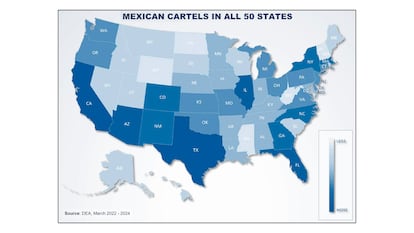
Another faction is led by El Mayo Zambada, who was at the top of the organization for three decades and was indicted for fentanyl trafficking by a New York court in February 2024. While the inclusion of Zambada and Los Chapitos is not news, there are some little-known details, especially given the secrecy surrounding El Mayo. “Zambada-García is reported to be in poor physical health, leaving the leadership of his faction in question,” the DEA notes of the 76-year-old capo.
The other two cells are controlled, according to the DEA, by Aureliano “El Guano” Guzmán Loera, El Chapo’s brother who holds influence in the so-called Golden Triangle (in the Mexican states of Sinaloa, Durango and Chihuahua), and Rafael Caro Quintero, a former ally of the cartel’s founders who has also been linked to the organization’s enemies. Cooperation between the factions is questioned by the DEA itself. “In reality, however, internal power struggles and fluctuating alliances leave the viability of the “umbrella model” in question,” the report states. “Los Chapitos are at the center of an internal battle against their father’s former partner, Ismael Zambada-García,” it adds. They also allude to disputes with Caro Quintero’s group, the so-called Caborca Cartel.
The DEA says the Sinaloa Cartel has been trafficking fentanyl since 2012, long before the United States put the synthetic drug at the top of its priority list, and blames Los Chapitos for the decision to make the illegal trade of the substance one of the organization’s main businesses. The agency also points out that their business is bigger than that of their CJNG rivals. “The Sinaloa Cartel dominates the fentanyl market through its manipulation of the global supply chain and the proliferation of clandestine fentanyl labs in Mexico,” it notes. The business model replicates the one used for methamphetamine trafficking, devised more than 25 years ago. The DEA goes beyond describing a commercial scheme and points the finger at the Chinese and Mexican authorities. “Despite controls levied by both the Mexican and Chinese governments, the flow of precursor chemicals into Mexico continues unabated,” the agency states.
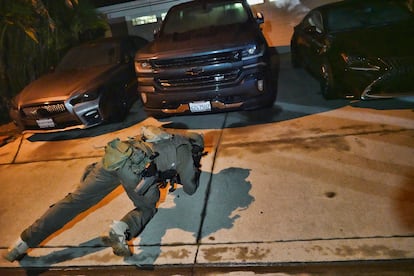
The DEA adds the Sinaloa Cartel is diversifying its chemical suppliers and is also looking to India, home to one of the world’s largest pharmaceutical industries. Among the 47 countries in which it has a presence, the cartel is looking at other markets. In Southeast Asia and Oceania, its main business is methamphetamines and “their profits can be more than 100 times higher than from U.S. sales,” according to the report. In Africa, the organization has points where it transships drug shipments to the European market. Its financial operators have been identified from Central and South America, through Spain and Morocco, to South Africa, Russia, and Australia.
In Mexico, the cartel controls the port of Manzanillo and most of the border with the United States, from Tijuana to Ciudad Juárez, according to the report. “The Sinaloa Cartel is able to operate freely in some parts of Mexico because they have a network of corrupt law enforcement, military, and political contacts,” the DEA says. At the end of its diagnosis, the report mentions new drug threats such as “tusi,” a “pink drug cocktail (mixture of two or more illegal drugs) consumed mainly in the club scenes of major metropolitan cities.” The Sinaloa Cartel, the report concludes, “is always looking to profit on the illegal drug trends of the moment.”
CJNG: blood ties and criminal franchises
The DEA describes the CJNG’s leadership as an amalgam of alliances sealed by “blood ties” and marriages in the extended family of Nemesio Oseguera Cervantes, alias “El Mencho.” His wife, Rosalinda González, has been charged with drug trafficking, as have two of his sons and at least five of his brothers-in-law, according to U.S. and Mexican court documents. His brother Antonio “Tony Montana” Oseguera was captured in Mexico last month, but later released for lack of evidence. González’s relatives head Los Cuinis, the cartel’s main allies. El Mencho is the undisputed leader of the front line of the organization, with a small group of lieutenants who report directly to him. Below them are a series of local capos, who oversee the organization’s regional businesses, according to the agency. “The Jalisco Cartel operates under a franchise business model,” it said.
These franchises allow each group to operate almost as an independent cell and to specialize in different points in the criminal chain, or to cater differently to the needs of their local markets. In return, they have to agree to “business practices” dictated by El Mencho’s leadership, such as including the CJNG “brand” and accepting guidelines on their operational structure. Decision-making is centralized, but it is the franchises that absorb the operating costs. The cartel takes a percentage of the profits and can expand more quickly, according to the DEA. The model, however, has weaknesses. “Individual franchise groups operating under the Jalisco Cartel name can form their own unique alliances with other criminal groups, some of which are in direct opposition to the alliances of other franchises,” the report states.
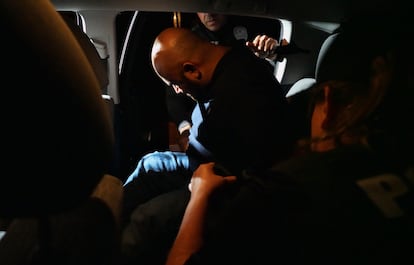
“Although the Jalisco Cartel cannot match the Sinaloa Cartel’s fentanyl production capacity, they have flooded American streets with fentanyl, often mixed with other drugs like heroin, cocaine, and xylazine,” the DEA states. Still, the federal agency points to the CJNG as the main supplier of cocaine to U.S. markets and says it is investing millions of dollars in profits to fund its expansion to other parts of the world, such as Japan, Australia, and Europe. The organization has representatives and allies in 40 countries, despite the fact that it was founded only 10 years ago, according to the report. It also characterizes the CJNG for its violence and accuses it of being behind the attacks against Omar García Harfuch, former chief of the Mexico City Police, in 2020 and against the convoy of Alejandro Giammattei, then president of Guatemala, in 2022. The victims, who were unharmed, are not mentioned by name.
The DEA does not lend credibility to the “narco-messages” that appeared in several Mexican cities in 2023, in which both cartels claimed they were going to impose a “ban” on fentanyl trafficking. The agency dismissed this as a “public relations stunt,” claiming there was no drop in the quantities of drugs seized and no increase in drug prices on U.S. streets. There were more than 59,000 opioid overdose deaths in the United States last year, according to provisional data from health authorities. The agency says the CJNG maintains control of the port of Manzanillo, the country’s main naval gateway to Asia, as well as several terminals in the Gulf of Mexico, such as Matamoros and Veracruz.
The U.S. government has launched a judicial offensive after the fall of El Chapo, targeting El Mayo and Caro Quintero, while Ovidio Guzmán and Rubén “El Menchito” Oseguera, son of the CJNG boss, are awaiting trials in the United States. The siege has reached high-profile Mexican officials, such as Genaro García Luna, secretary of public security in the Felipe Calderón administration, who was convicted of collaborating with the Sinaloa Cartel over the past two decades. Despite tensions with Mexican authorities, the ongoing crusade against the cartels is made explicit in the report. “DEA’s top operational priority is to relentlessly pursue and defeat the two Mexican drug cartels — the Sinaloa Cartel and the Jalisco Cartel — that are primarily responsible for driving the current fentanyl poisoning epidemic in the United States,” it concludes.
Sign up for our weekly newsletter to get more English-language news coverage from EL PAÍS USA Edition
Tu suscripción se está usando en otro dispositivo
¿Quieres añadir otro usuario a tu suscripción?
Si continúas leyendo en este dispositivo, no se podrá leer en el otro.
FlechaTu suscripción se está usando en otro dispositivo y solo puedes acceder a EL PAÍS desde un dispositivo a la vez.
Si quieres compartir tu cuenta, cambia tu suscripción a la modalidad Premium, así podrás añadir otro usuario. Cada uno accederá con su propia cuenta de email, lo que os permitirá personalizar vuestra experiencia en EL PAÍS.
¿Tienes una suscripción de empresa? Accede aquí para contratar más cuentas.
En el caso de no saber quién está usando tu cuenta, te recomendamos cambiar tu contraseña aquí.
Si decides continuar compartiendo tu cuenta, este mensaje se mostrará en tu dispositivo y en el de la otra persona que está usando tu cuenta de forma indefinida, afectando a tu experiencia de lectura. Puedes consultar aquí los términos y condiciones de la suscripción digital.
More information
Archived In
Últimas noticias
Most viewed
- Sinaloa Cartel war is taking its toll on Los Chapitos
- Reinhard Genzel, Nobel laureate in physics: ‘One-minute videos will never give you the truth’
- Oona Chaplin: ‘I told James Cameron that I was living in a treehouse and starting a permaculture project with a friend’
- Why the price of coffee has skyrocketed: from Brazilian plantations to specialty coffee houses
- David King, chemist: ‘There are scientists studying how to cool the planet; nobody should stop these experiments from happening’

